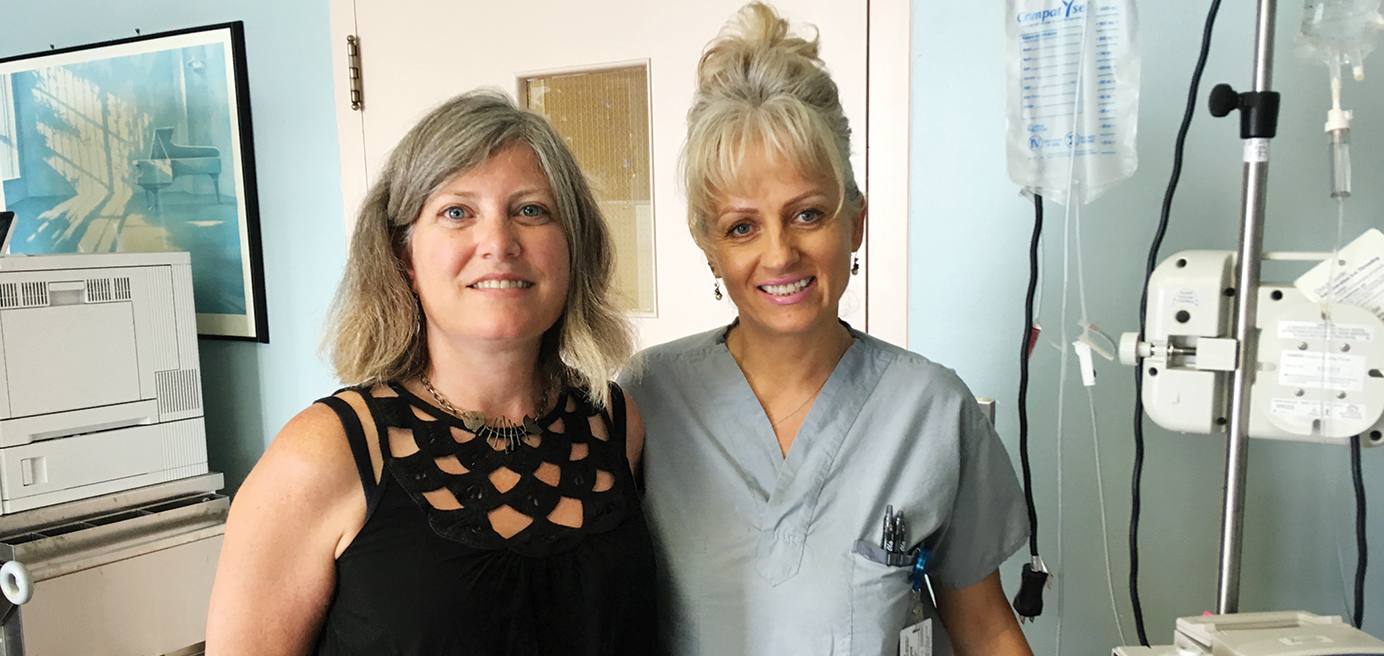 'Rock Bottom'
'Rock Bottom'

PERSISITENT PURSUIT Burnaby Hospital post anesthesia care unit nurse Renata Lalonde (right) successfully used the professional responsibility process to secure much-needed staff on her unit. She was supported by BCNU full-time steward Tracey Hulme (left).
Ihave never had to advocate so much!" exclaims Renata Lalonde.
The seasoned nurse has spent the last 15 years working at Burnaby Hospital, where she began in the surgical ward and emergency department. But for the last three years she has worked in the post-anesthesia care unit (PACU).
Lalonde is no stranger to the challenging staffing conditions that come with working in a large and busy facility – Burnaby Hospital has 286 beds with 70,000 visits annually – but the chronic short staffing and risks to patient safety she encountered within the PACU motivated her to use the professional responsibility process (PRP) to safeguard her practice and protect her patients.
The PRP is an important part of the Nurses' Bargaining Association's (NBA) collective agreement, and it's a tool that lets members report critical incidents such as those that jeopardize patients' safety. Under the PRP, BCNU and health employers are expected to come together and resolve safety issues when nurses feel their ability to meet professional standards is being threatened. When raising concerns, nurses have the opportunity to describe the events or circumstances that contributed to their concern. The process allows them to address issues such as employer policies and procedures, workload and staffing and workplace communication.
There are seven operating rooms at Burnaby Hospital, where surgeries are performed year-round. PACU helps stabilize the approximately 40 patients a day that come out of the OR after hip and knee replacements and other types or orthopedic surgeries. PACU nurses monitor airways, treat pain, ensure a patient's vital signs are normal, and that they are alert and responsive before being released or transferred to another unit for further care. The Burnaby Hospital PACU is staffed by nine full-time nurses and about four part-time nurses between 7:30 a.m. and 11:30 p.m., with additional on-call nurses for emergency evening surgeries. It's a high acuity environment that requires a patient-nurse ratio of two-to-one, unless a patient is vented – when the ratio should be one-to-one.
The high volume of patients also means staffing levels have to be optimal at all times. Unfortunately, because the PACU at Burnaby Hospital doesn't have the staffing to support safe recovery, the OR is often placed on hold and a log-jam is created until the receiving unit is able to safely transfer stable and recovered patients, and resume accepting new ones.
"The program clerk was asking us to come in early, stay late and come in on our days off."
It's a stressful situation for nurses, as the PACU will also receive push-back from OR staff when their unit is placed on hold. The chronic short staffing means nurses are caught in a tug-of-war between wanting patients to recover safely and ensuring further operations are not delayed.
Lalonde reports that she and her co-workers were burning out from the volume of extra shifts and overtime they were working to cover baseline staffing. There simply weren't enough nurses scheduled and there were never any replacements for nurses on sick or holiday leave.
She says that she and the other nurses had reached "rock bottom."
After having discussions with Burnaby Hospital full-time steward Tracey Hulme in January 2017, Lalonde decided to take the first step in the PRP by having a conversation with her excluded manager. At a meeting the following February she highlighted the fact that nurses on her unit worked short-staffed for 25 days in December 2016 and a day in January 2017 that involved the OR being placed on hold several times throughout the day.
"We had often been working short, vacations were not replaced and sometimes people were sick," reports Lalonde. She says that she and her fellow nurses asked for staff levels to be increased, and that all absences be replaced.
Unfortunately, the discussion did little to improve the staffing deficiency. In fact, it appeared that the employer was downplaying the situation. "Management said there were simply no nurses to call in to help," says Lalonde. "The program clerk was asking us to come in early, stay late and come in on our days off."
Unsatisfied with the employer's response, and with no major solutions forthcoming, Lalonde decided to escalate her professional practice concerns to step two of the process by filing a professional responsibility form (PRF) the following March. The PRF allows nurses to explain their concerns in writing and record why they are seeking change. Lalonde's PRF went to her worksite Professional Responsibility Committee (PRC), which is comprised of two standing members, (one from the Nurses' Bargaining Association [NBA] and one from the employer) as well as the nurse with the concern, a union rep and the excluded manager. Under the PRP, after a PRF is filed, the PRC must hold a meeting within 14 days. After this meeting, the PRC has 30 days to submit a final written report including action items and timelines.
Lalonde's PRF resulted in the creation of one new part-time position, but she says it was not nearly enough to alleviate the staff shortage. "The response was very disappointing and only tip-toed around the issue of staffing levels," states Hulme, who worked with Lalonde through the PRP. Lalonde decided to file another PRF. Hulme says that Lalonde's determination was admirable. All of the PACU nurses wanted to see change, but it was Lalonde who did the heavy lifting, she says.
When the PRC met again in April, the parties agreed to an action plan and committed to reassess the situation within 60 days. Unfortunately, there was still no action after 60 days and more meetings. "Nothing had really changed around the staffing crisis," says Lalonde. It was evident to her that circumstances were not improving.
If a practice issue cannot be resolved by the PRC, it can be referred to step three of the PRP, and can take one of two paths: practice concerns not directly related to staffing are dealt with by the senior review committee (SRC) – a health authority-wide body with union and employer reps. But if the hiring of additional staff is needed to address the practice concern, it is referred to the health authority's Nurse Relations Committee (NRC). This new committee was established under the terms of the NBA 2014-2019 collective agreement that was ratified in May 2016. The NRC is composed of union representatives and employers who meet bi-weekly.
In this case, both PRC co-chairs agreed to advance the issue to the NRC after it became evident that no local resolution could be reached.
Hulme acknowledges that 2017 was indeed a difficult year for Burnaby Hospital PACU nurses, many of whom continued to work under trying conditions while waiting for a resolution to their practice concerns. "Another nurse in the PACU filed another PRF in August related to staffing concerns," she reports. "There was no nurse for the first day shift, no evening on-call nurse and no night nurse available – at one point Lalonde was by herself and had to recover her patient in the ICU."
But a combination of relief and pride swept the PACU when nurses received news in May 2018 that employer reps on the NRC agreed to increase the unit's staffing by 3.9 FTE permanent positions.
Lalonde feels more than justified in her pursuit of additional staffing. "It was definitely a lot of time and effort, and you have to work hard to document," she says. "This news was incredible. It demonstrated how short our department was and how much help we needed to keep patients safe."
Lalonde reports that the new positions will only be posted after the unit finishes revamping its rotation schedule.
"But everyone in the PACU is very happy," she says.
UPDATE (October 2018)

